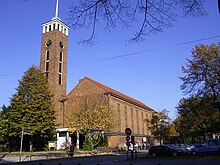Friedrich Dyrssen
Friedrich Dyrssen (born October 28, 1890 in Berlin , † April 15, 1957 in Hamburg ) was a German architect .
Life
Dyrssen graduated from high school in Gotha in 1911 and studied architecture in Hanover , Munich , Danzig and - after interruptions due to military service and imprisonment - at the Technical University of Berlin-Charlottenburg . There he completed his studies with German Bestelmeyer with a diploma and was assistant at his chair for a short time until he moved to Fritz Höger's architecture office in Hamburg in 1921 . Here he was involved, among other things, in the planning and construction of the Chilehaus in the style of brick expressionism.
In 1924 he opened the architecture office Dyrssen & Averhoff in Hamburg together with Peter Averhoff , also a former Höger employee . Together they successfully participated in numerous competitions and in 1927 were commissioned to build the airport reception building in Hamburg. In the Weimar Republic , Dyrssen approached the international style , but kept brick as a building material.
From 1929 to 1934 he was also chairman of the Hamburg regional group in the Association of German Architects .
During National Socialism, however, Dyrssen also oriented himself to the given direction of homeland security and continued to be involved in numerous construction projects such as apartments, HJ homes and air raid shelters, especially in Hamm , Finkenwerder and Barmbek-Nord .
After the outbreak of World War II, Dyrssen and Averhoff belonged to Konstanty Gutschow's extended group of employees and were commissioned to work on the redesign of Hamburg and in the context of the construction of air raid shelters. Appointed DAF architects of trust in 1940 , they also became urban planning and technical consultants for the SAGA housing association . A war wound saved Dyrssen from being deployed to the front.
Even after the end of the war, working at SAGA led to orders for the reconstruction and new construction of the housing company. In addition, Dyrssen and Averhoff took part in various urban planning competitions (in addition to Hamburg, also in Kiel and Lübeck).
After his partner Averhoff died in 1954, he took on Gert Johannsen as a new partner in 1955 . Dryssen worked with him until he died in 1957 after a biliary operation. Johannsen continued to run the office.
plant
- 1920s: Friedrich-Naumann-Strasse settlement in Harburg (today Hamburg-Heimfeld ; destroyed; remaining buildings that cannot be assigned to Nobléestrasse 13a, 15)
- 1925–1926: Max-and-Mathilde-Bauer-Stift in Hamburg
- 1926–1927: Atelier for Richard Kuöhl in Hamburg
- 1926–1930: "Vaterstädtische Siedlung" in Hamburg-Eimsbüttel, Kielortallee 25/26 (together with Peter Averhoff)
- 1926–1928: Entrance building for Fuhlsbüttel Airport (together with Peter Averhoff)
- 1928–1929: Administration building of the general local health insurance fund in Wandsbek, Bleicherstraße 74/77 (today Kattunbleiche 35 in Hamburg-Wandsbek )
- 1929–1930: House Radicke in Harburg (today Hamburg-Wilstorf ), Radickestrasse 31
- 1936: HJ-Heim Martinistraße in Hamburg
- 1935–1936: Good News Church in Hamburg-Dulsberg , Straßburger Platz 2
- 1938–1941: Housing estate on Ostfrieslandstrasse in Hamburg
- 1941–1942: Bunker on Bornplatz in Hamburg
- 1953: Reconstruction of the Good News Church in Hamburg-Dulsberg , Straßburger Platz 2
- 1954–1954: Christ-König-Kirche in Hamburg-Lokstedt
literature
- Jan Lubitz: Dyrssen, Friedrich . In: Franklin Kopitzsch, Dirk Brietzke (Hrsg.): Hamburgische Biographie . tape 5 . Wallstein, Göttingen 2010, ISBN 978-3-8353-0640-0 , p. 98-99 .
Web links
| personal data | |
|---|---|
| SURNAME | Dyrssen, Friedrich |
| BRIEF DESCRIPTION | German architect |
| DATE OF BIRTH | October 28, 1890 |
| PLACE OF BIRTH | Berlin |
| DATE OF DEATH | April 15, 1957 |
| Place of death | Hamburg |

